2000 Lexus Rx300 Diagnostics Read P0171 System Too Lean Bank 1
Lawmaking P0171 - System Also Lean: Symptoms, causes, common bug, diagnostic
Updated: July 10, 2021
The OBDII trouble code P0171 - Arrangement Too Lean (Banking concern ane) ways that the engine air-fuel mixture is too lean, or at that place is besides much air and too little fuel. Driving a car with the code P0171 can cause more damage to the engine over time, equally when the engine runs lean, the combustion temperature is college.
Symptoms:
When an engine runs lean it lacks power and may stall when the machine is stopped at a finish sign. The acceleration may also feel slow. The engine may run crude at idle. If this lawmaking is caused by a vacuum leak, there might be a hissing racket coming from the engine. Read more nigh vacuum leaks. The engine may also be hard to start. Another symptom of an engine running lean is when there is an engine knock or detonation (pinging) nether load or when accelerating uphill.
Causes:
Common causes include:
- Vacuum leaks
- Clogged or faulty Mass Air Menstruation sensor (MAF)
- Faulty PCV valve or other parts of PCV system
- Stuck open purge valve/solenoid
- Faulty oxygen sensor
- Improperly installed aftermarket intake
- Low fuel pressure
- Clogged-upward catalytic converter
How the code P0171 is diagnosed:
With a good scan tool that shows the live data diagnosing the code P0171 is fairly easy. Without a browse tool, the only style to find the problem is to bank check the basics and research mutual problems with your detail car make, twelvemonth and model. We take done some research and posted common problems for some cars, please read further. The best identify to accept your automobile for diagnostics is your local dealer - their technicians are factory-trained and know the mutual problems with the cars they service.
Bones checks under the hood include: is the air filter box properly closed? Does the intake boot have any cracks? Are any of the vacuum lines or hoses disconnected?
If you take a scan tool, check Short Term Fuel Trim (STFT) and Long Term Fuel Trim (LTFT) readings at idle and at higher rpms (read more virtually fuel trims below). Normally, both LTFT and STFT should be close to cypher. If the STFT rises higher than plus xv-20% at idle, but drops at higher rpms, most likely y'all have a vacuum leak. If the STFT is close to null at idle, only elevates to 15-xx% at college rpms, the problem could exist caused a faulty mass air catamenia sensor, chock-full catalytic converter or low fuel pressure (bad fuel pump). Read more about using a scan tool here.
What is Intake or Vacuum leak?
An air leak anywhere betwixt the engine intake and the mass air period sensor is often called a 'vacuum leak' or 'intake leak'. Common examples of vacuum leaks include a ripped or cracked intake boot, leaking intake manifold gaskets, stuck-open or defective PCV valve or ripped PCV hose, cracked or disconnected vacuum line. Read more than: Vacuum leaks: common sources, symptoms, repairs. Here are a few examples of intake or vacuum leaks:
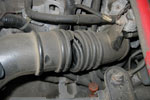
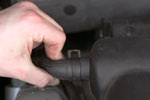
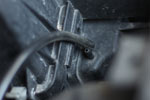

Common problems causing the lawmaking P0171 in dissimilar cars:
One manner to find a common problem with your make and model is to search for technical service bulletins (TSBs). For instance, the Toyota Technical Service Bulletin (TSB) EG045-07 for the 2003-08 Toyota Corolla and Matrix with the 1ZZ–FE engine mentions a leaking intake manifold gaskets in subfreezing temperature as a possible reason for the code P0171 forth with some other codes. If the leaking manifold gasket is confirmed post-obit the diagnostic steps, information technology must exist replaced.
Many Ford vehicles, including Explorer and F150 had a common problem with leaking gaskets betwixt the upper and lower intake manifolds causing the codes P0171 and P0174. Ford has issued a technical service bulletin on this consequence. Some other known issue in Ford vehicles is a vacuum leak from a ripped-through safety elbow on one of the vacuum lines at the back of the intake manifold. Some V6 Mazda vehicles (Tribute, MPV) also have this event where the safety elbow at the back of the intake manifold rips through, causing a vacuum leak and the code P0171.
A croaky or ripped intake kicking is a mutual reason for the code P0171 in many BMW vehicles.
The service bulletin for Nissan Maxima dated March 2004 mentions replacing an air/fuel sensor every bit a solution for the code P0171. Another Ford TSB for a number of late 90-due south Ford vehicles describes a problem with MAF sensor contamination where both codes, P0171 and P0174 would appear together.
Issues with the mass air flow (MAF) sensor causing the code P0171 are fairly common in many vehicles. Sometimes the mass air catamenia sensor just gets dirty and gives fake air flow readings causing the engine to run lean. Cleaning the air menstruation sensor may help temporarily; the proper repair involves replacing the faulty mass air flow sensor. A mass air catamenia sensor tin be tested with a scan tool; read more than hither: mass air catamenia sensor.
Bones automobile knowledge: how the air/fuel ratio is adjusted
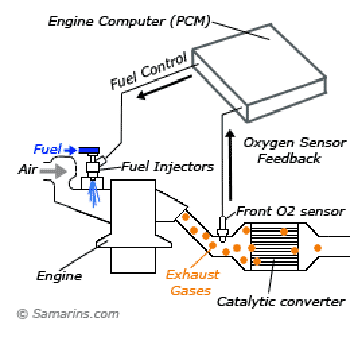 Fuel Trim Control diagram
Fuel Trim Control diagram
In modern cars with the OBD-2 system, the front oxygen sensor measures the corporeality of oxygen in the frazzle gases and provides the feedback indicate to the engine computer (PCM) whether the air-fuel mixture coming into the engine is lean (as well much air and too little fuel) or rich (besides much fuel and likewise little air).
The PCM adjusts the fuel supply accordingly to proceed the air/fuel ratio at the optimum level, which is 14.7/one (fourteen.seven parts of air to i part of fuel).
This process is continuous: when the oxygen sensor detects as well much oxygen, the PCM assumes that the air/fuel mixture is lean and adds more fuel. When in that location is too petty oxygen in the exhaust (air/fuel mixture is rich), the PCM reduces the amount of fuel. In technical linguistic communication this adjustment is called fuel trim.
What is Fuel Trim?
Short term fuel trim (STFT) Once the front oxygen sensor is warmed up after a cold first, the engine estimator (PCM) starts cycling the air/fuel ratio between a niggling lean and a fiddling rich. This cycling happens effectually once or twice per second. This air/fuel ratio adjustment is called short term fuel trim (STFT). You can encounter this cycling on the graph here: air fuel ratio (oxygen) sensor. A typical scan tool displays the STFT equally a percentage with "-" or "+" in the Live Data way. For example, if your car had a pocket-size vacuum leak, y'all would see the STFT going up to + 10-15% at idle and dropping to + iii-5% at higher rpms.
Long-term fuel trim (LTFT) There is also a long-term fuel trim (LTFT), which is a long-term compensation of the base air/fuel ratio. For case, if over time, the engine gradually develops a small vacuum leak, it makes the engine run bacteria (more air and less fuel). In a long term, the engine computer (PCM) will compensate this condition past adjusting the long-term fuel trim (LTFT) to add more fuel. The long-term fuel trim is also displayed equally a percentage with a "-" or "+" sign in a scan tool. For example, a long-term fuel trim (LTFT) at +5% means that the PCM has added some fuel, although 5% is considered within normal range.
How the code P0171 is set up
If the air-fuel mixture becomes besides lean and the engine reckoner can no longer compensate for this condition by adding fuel, the engine computer (PCM) turns the "Check Engine" light (MIL) ON and sets the trouble code P0171 - System Too Lean for Bank one and (or) P0174 - Organisation As well Lean Banking company 2, depending on which cylinder bank is affected. The PCM likewise stores the freeze frame of the parameters (engine temperature, vehicle speed, fuel trim readings, etc.) at the fourth dimension when the code was prepare. Typically, the code P0171 is set when either short term fuel trim (STFT) or long term fuel trim (LTFT) adjustment exceeds a certain value (normally +25%). Read more than about the freeze frame.
What does the term "Banking concern 1" mean?
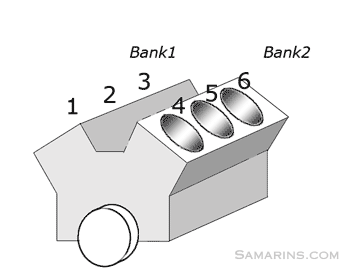 Bank1 and Bank2 in a V6 engine.
Bank1 and Bank2 in a V6 engine.
The terms "Depository financial institution 1" and "Bank ii" refer to a separate group of engine cylinders. Most in-line 4-cylinder engines have only one bank: Bank 1. In V6 and V8 engines, as well as in some 4-cylinder engines, the engine is "split" into two groups of cylinders; the Banking company 1 is the one that includes the cylinder number i. To know which is Banking concern 1 and Bank 2 in your car, you can look information technology up in the repair transmission or google information technology, mentioning the year, make, model and engine size of your automobile.
Q: What could cause the code P0171 on 2002 Toyota Corolla? A: In the 2002 Corolla, the code P0171 is frequently caused by a bad or dirty mass airflow sensor or vacuum leaks. Your mechanic can check for vacuum leaks and test the mass airflow sensor with a scan tool. If the mass airflow sensor is causing the lean condition, cleaning it may assistance, but usually, it will need to be replaced. There too could be some other reasons, but the air menstruation sensor and vacuum leaks are the most common.
Source: https://www.samarins.com/diagnose/p0171.html
0 Response to "2000 Lexus Rx300 Diagnostics Read P0171 System Too Lean Bank 1"
Post a Comment